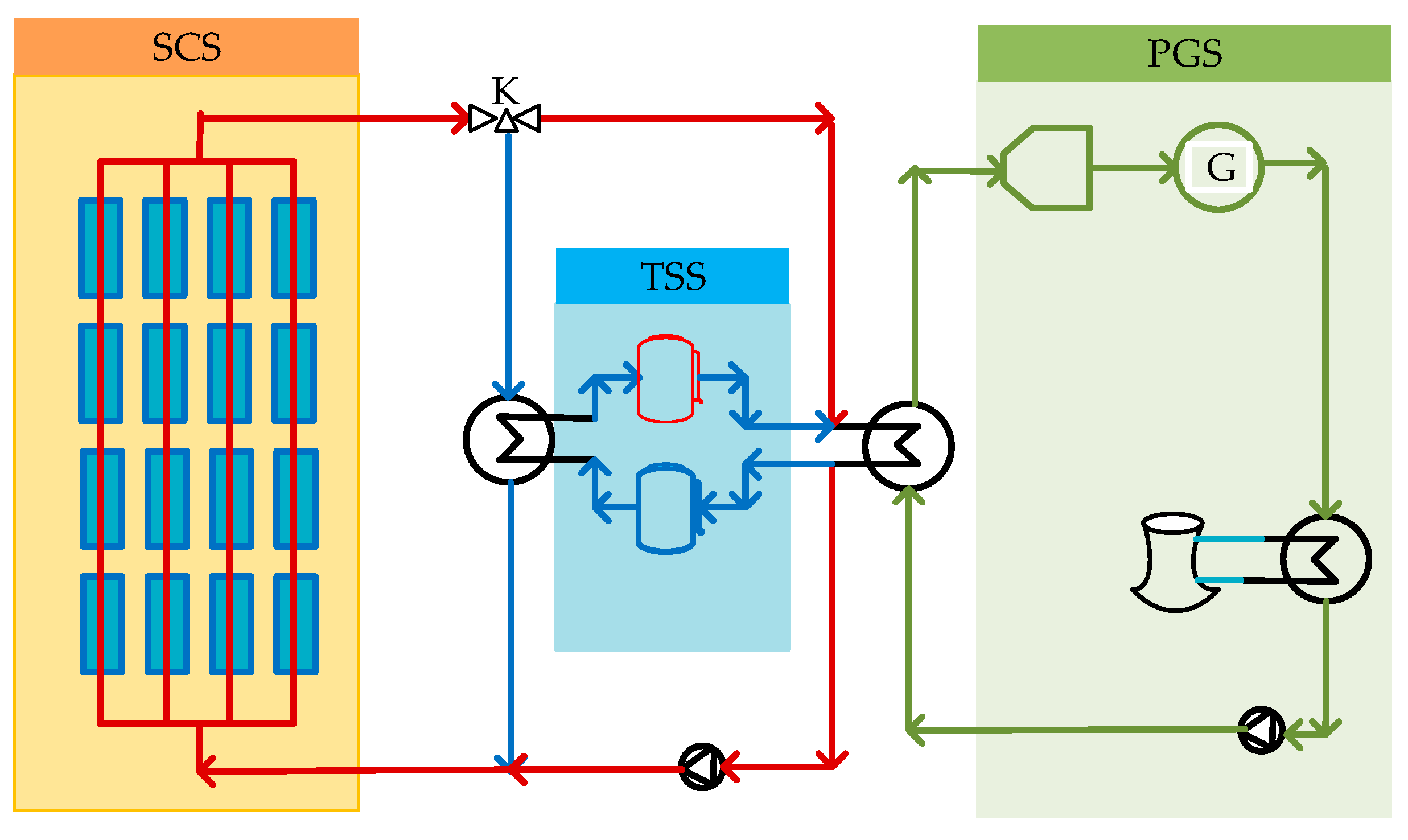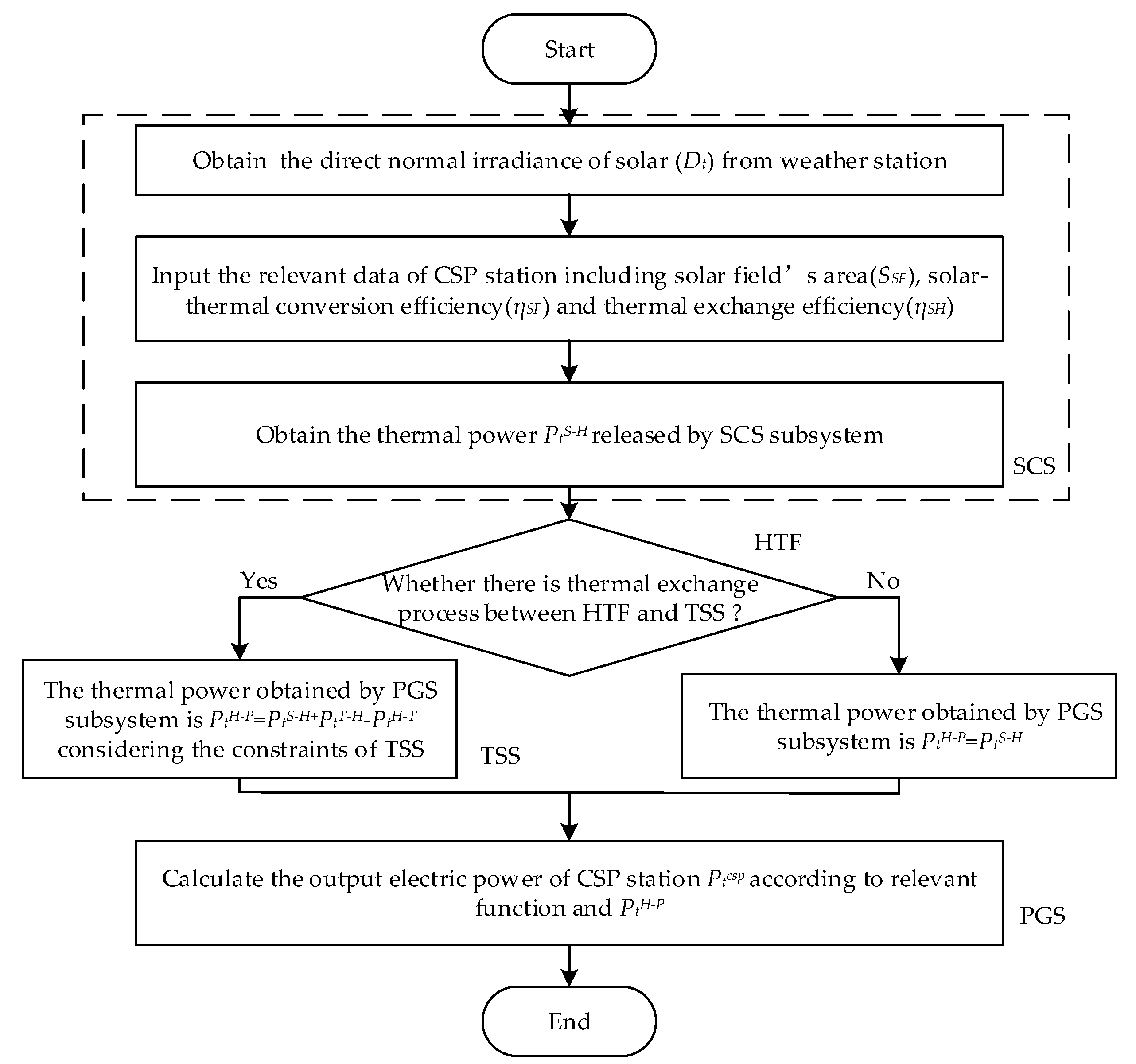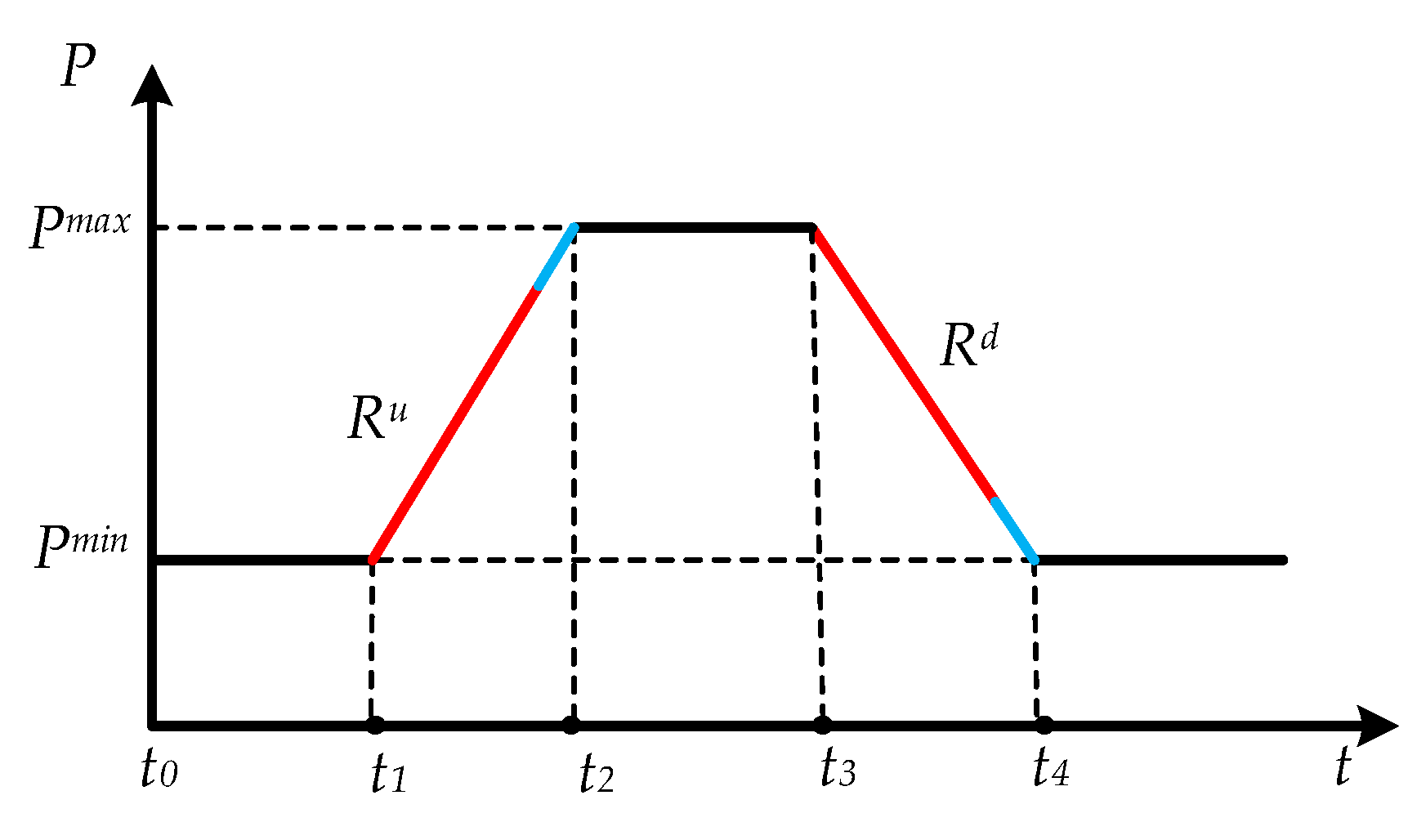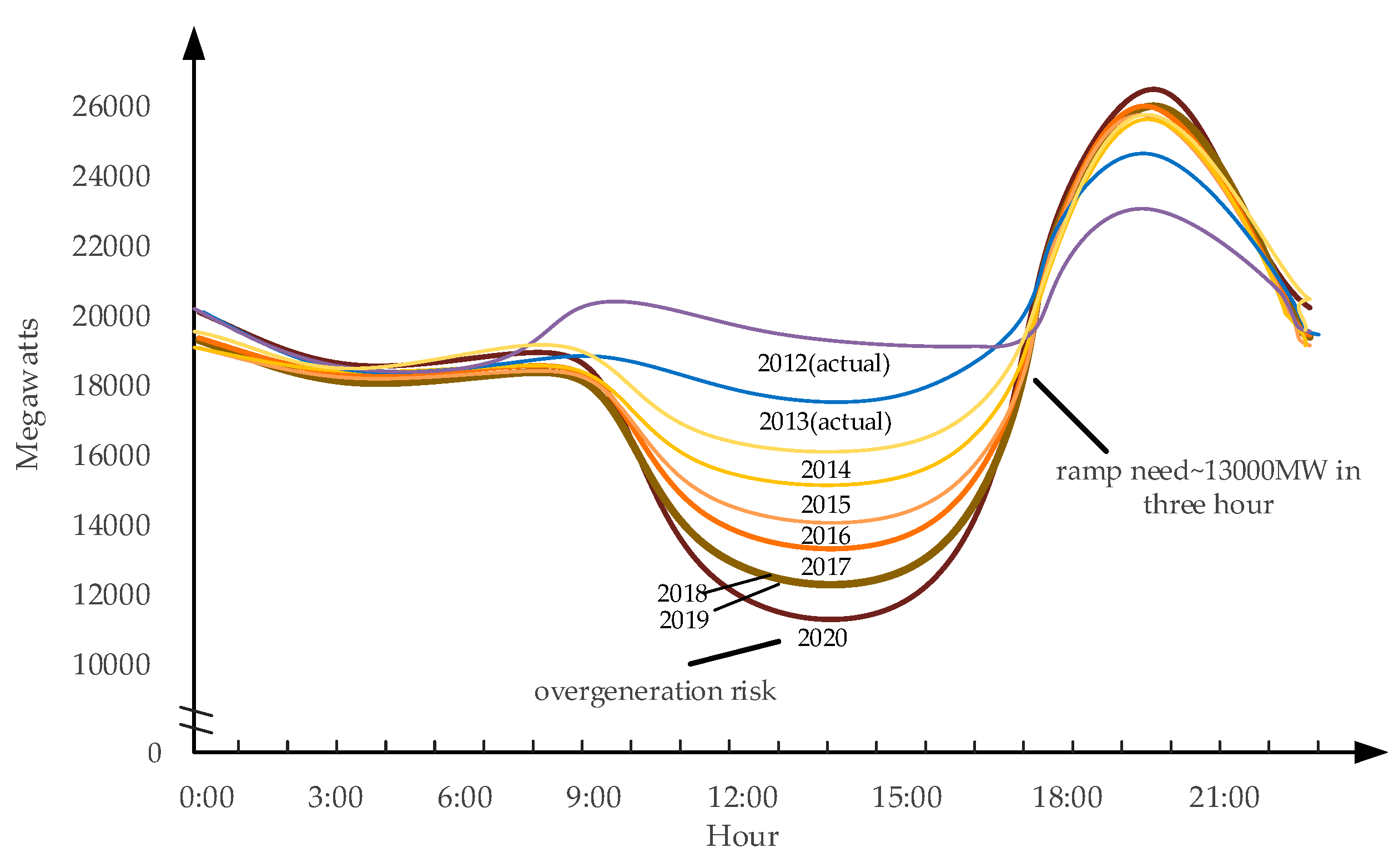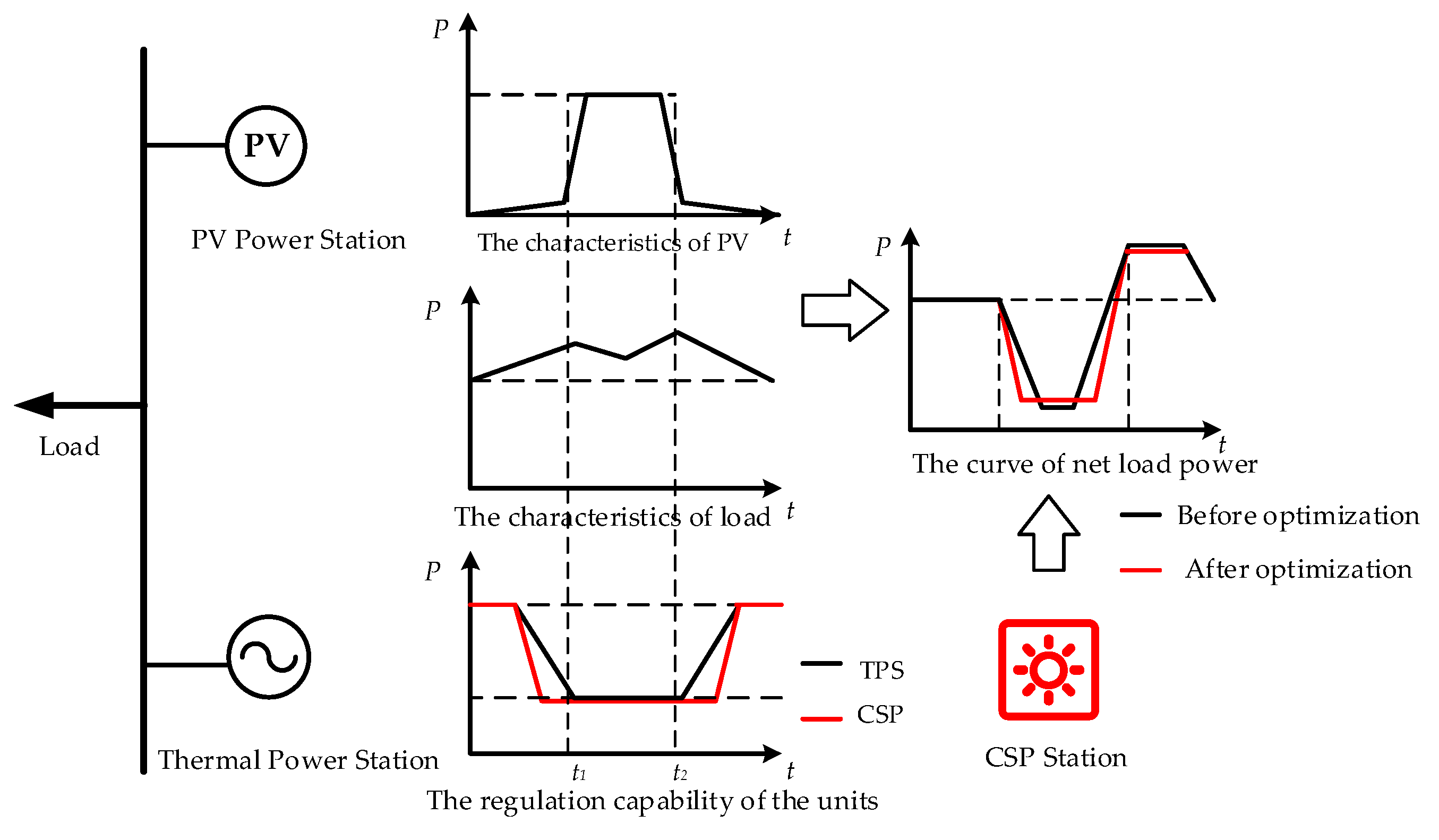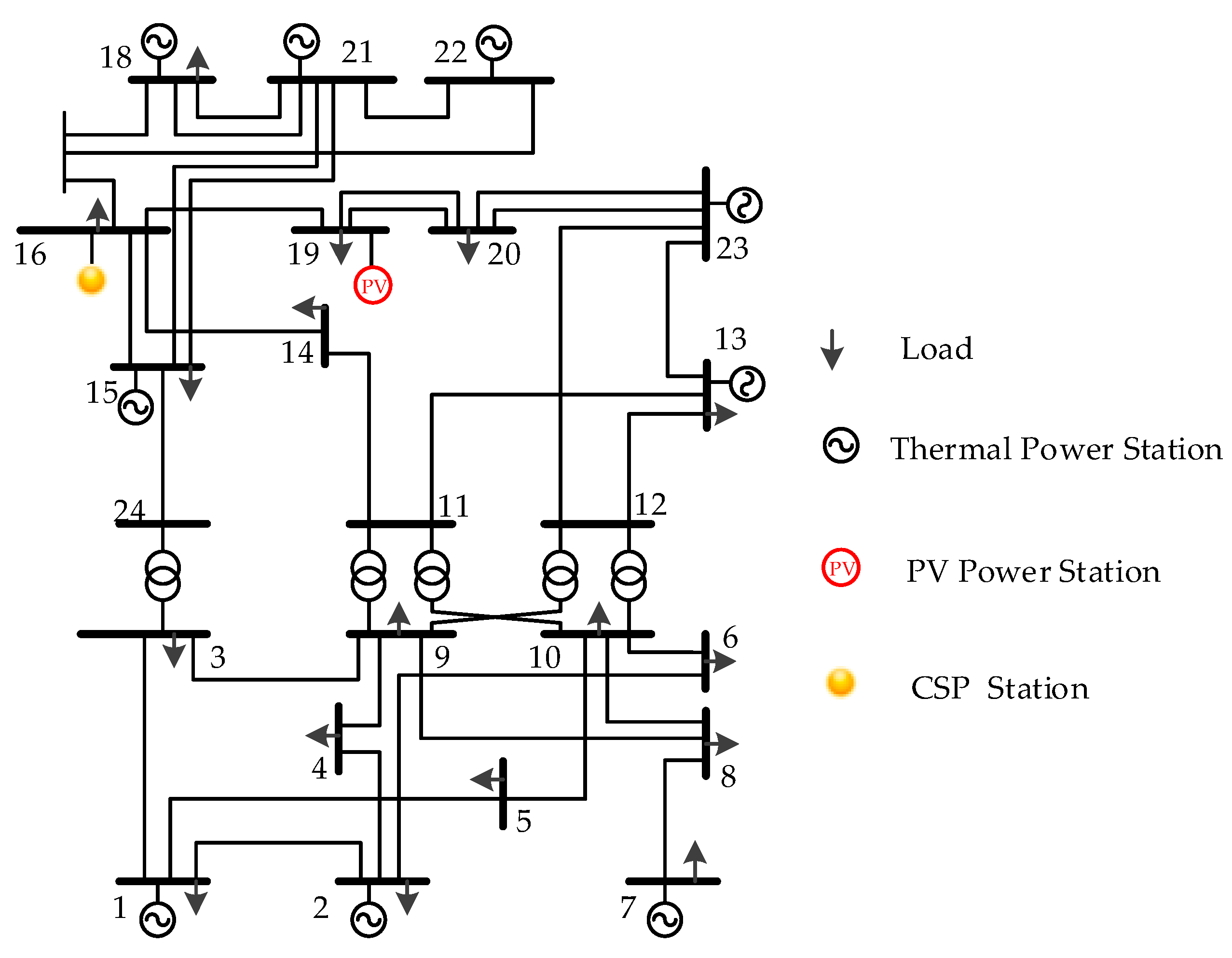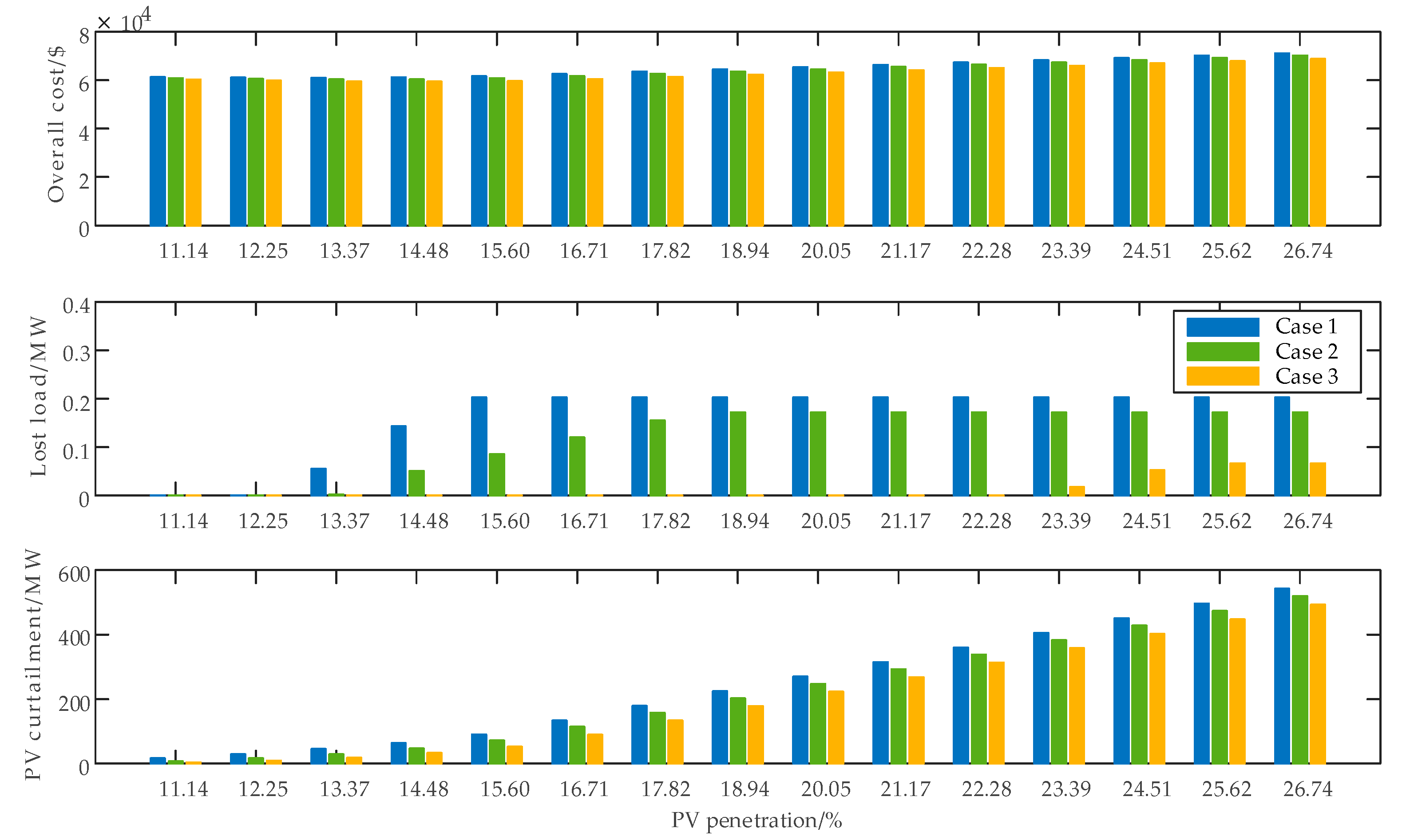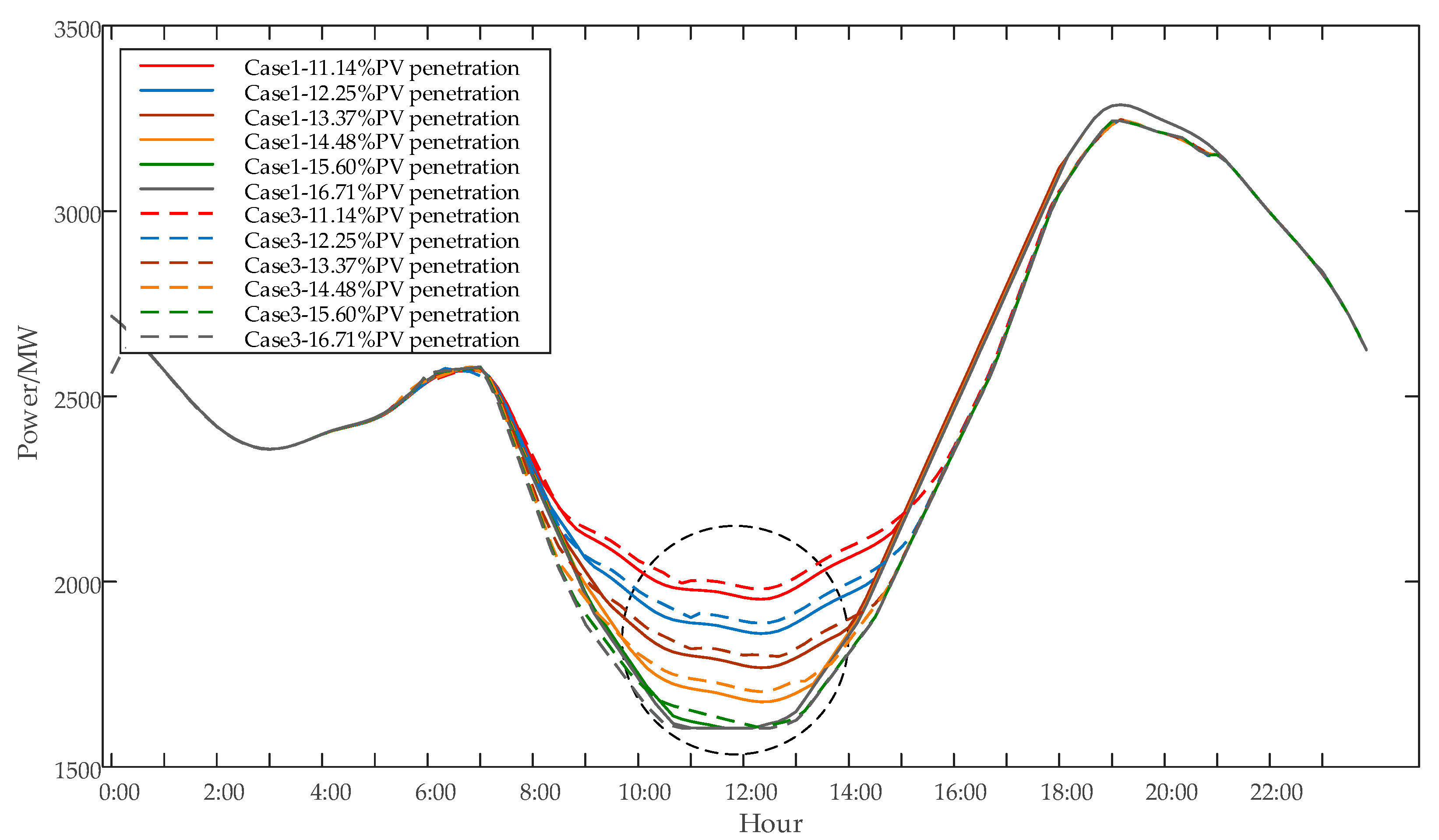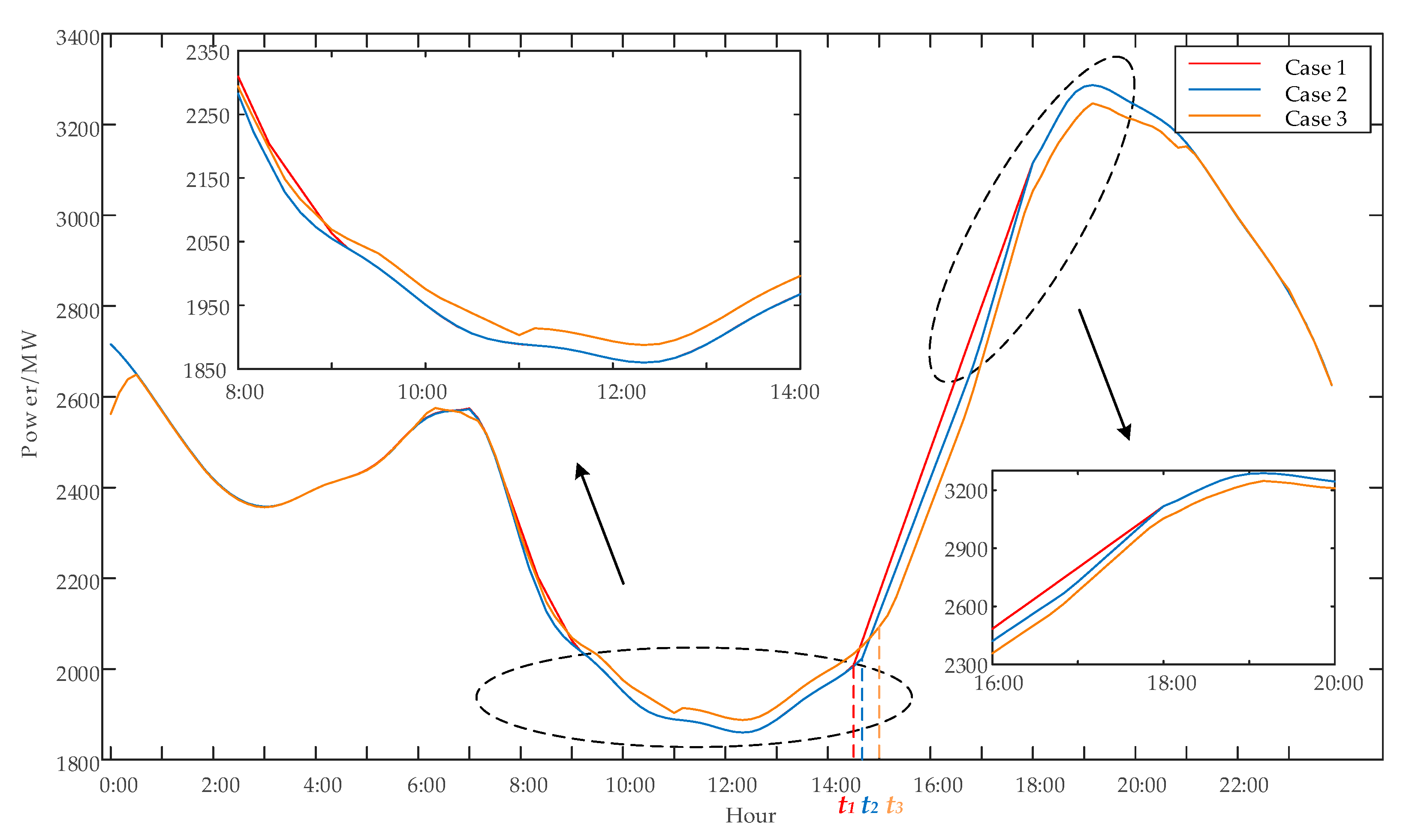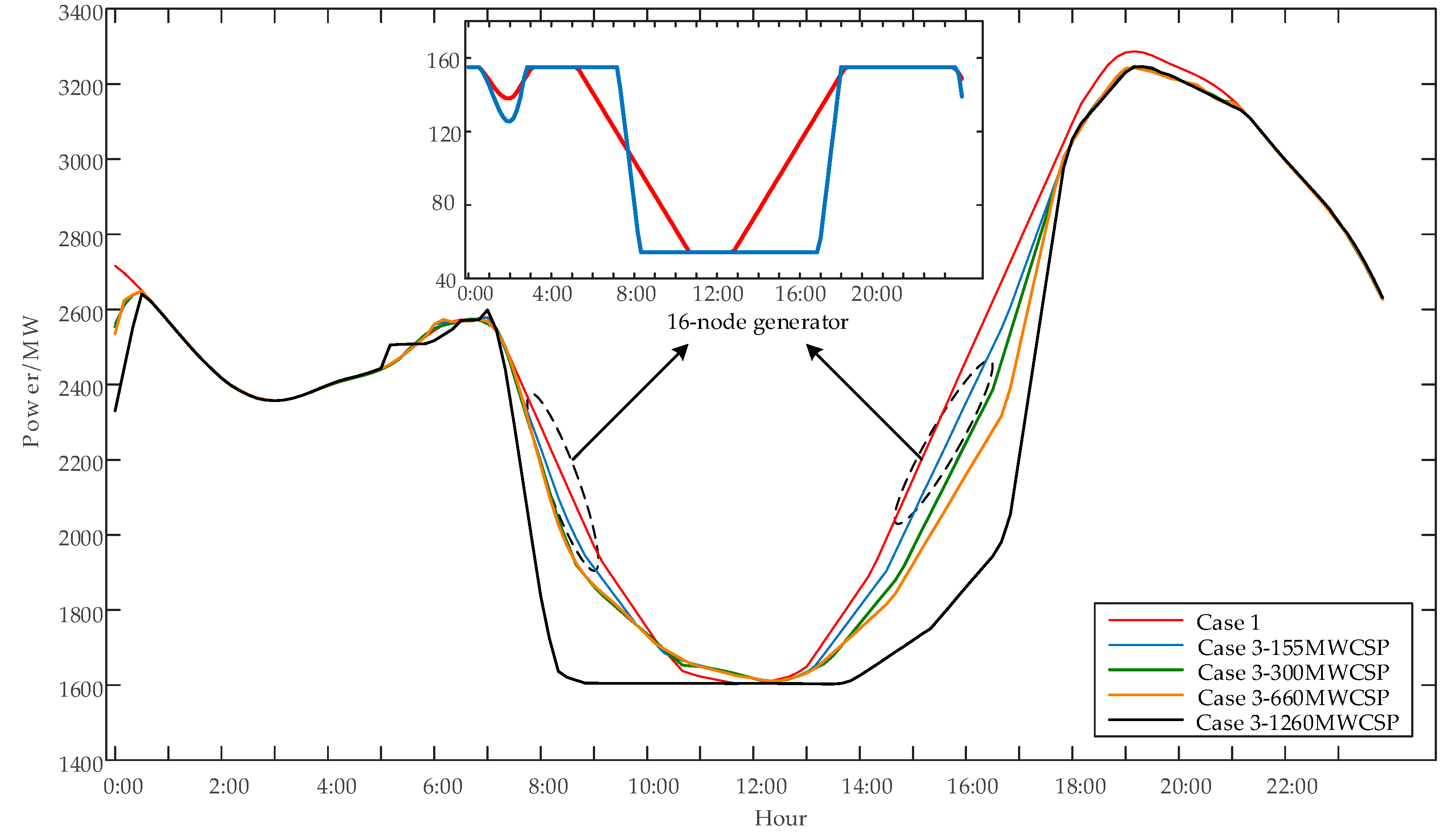1. Introduction
Photovoltaic (PV) power generation is the mainstream of solar power generation due to the reduction of PV modules’ raw material cost and policy support [
1,
2,
3]. However, the output curve of PV power generation is a semi-envelope shape with a single midday peak due to its intermittence and fluctuation [
4]. Its variation trend does not match with the typical daily load curve with double peak in terms of time, resulting in the net load curve resembling duck silhouette that is known as duck curve [
5]. The total load power curve minus the renewable energy generation curve is defined as the duck curve [
6]. The concept of duck curve is intended to graphically depict the problem of excessive generation during the midday and insufficient supply for rapid ramp in a short time at sunset in the conventional power system. The duck curve problem will result in curtailment of PV power largely and imbalance between power supplies and load demand seriously, threatening the safe and stable operation of power system [
7,
8].
Currently, the mitigation strategy for solving duck curve problem is primarily carried out from two aspects: mining the potential of demand-side response and improving the flexibility of power generation side.
With the application of smart meters, smart appliances, such as air conditioners and water heaters, can aggregate the response potential to narrow down the peak-valley difference of load for reducing the slope of ramping [
9,
10,
11]. Such measures are mainly applied for load centers with substantial distributed PV. While the scenario considered in this paper is the large-scale renewable energy delivery area where there’re few schedulable demand responses, so the second aspect is the major consideration.
At present, the main approaches of increasing power generation side flexibility include: (1) Retrofit conventional thermal power stations (TPS). In [
12], the renovation of TPSs changed its minimum generation requirements to eliminate PV curtailment at noon. An automatic load gain control strategy based on condensate throttling facilitated the TPSs’ load following performance for ramp need [
13]. (2) Control the real-time orientation of solar panels flexibly. This approach makes the PV output grid-friendly but increases the amount of PV curtailment [
14]. (3) Deploy flexible power supplies. Pumped-storage stations and gas turbines have been widely utilized in conjunction with renewable energy station to reduce the fluctuation of its power integrated [
15,
16]. Additionally, as a representative of the burgeoning power supply technologies, the deployment of energy storage device can time-shift the load demand to turn the duck curve into a straight line [
17].
However, in our scenario, such as Gansu province, China, it deploys numerous PV power stations without matched hydro-power and gas resources. Meanwhile, due to the economic factor, grid-side energy storage cannot be configured on a large scale [
18]. Concentrating solar power (CSP) generation technology is another emerging controllable solar power generation technology, which has the superior regulation capability to regulate output more accurately and quickly by equipping thermal storage system (TSS) with a certain capacity [
19]. The development of CSP generation technology provides a new thought to mitigate the impacts of duck curve on power system. Therefore, the CSP station with better regulation capability should be dispatched to mitigate the duck curve problem. It can form a multi-energy complementary system with PV power stations or wind power stations to improve the accommodation of renewable energy [
20,
21]. Furthermore, the CSP station equipped with TSS has technical and economic competitiveness due to the lower investment cost of thermal storage technology parallel with the mainstream electric energy storage technology, so it can also time-shift peak load strategically by storing thermal energy during the day and generating electricity at sunset [
22]. Extensive researches on the modeling and application of CSP generation technology have been done, the regulation capability of which is considered to provide a beneficial support function in the future high renewable energy penetrated power system [
23,
24]. Generally, the CSP model can be divided into two categories according to different application scenarios: (1) Dynamic model. Based on the modeling of differential equations, its time scale can be accurate to the level of seconds, which is mainly applied to imitate the real-time operating condition of CSP station for transient fault analysis [
25]. (2) Static model. Based on the modeling of steady-state difference equations, its time scale can only reach the hour level, which is suitable for developing the economic optimal dispatching strategies of the CSP station participating in the power system operation [
26]. From the research emphasis of this paper, the static model is more applicable for analyzing the day-ahead optimal dispatching operation of power system including CSP station.
CSP station needs to consider two points to solve the duck curve problem: (1) the risk of over-generation in the duck belly at noon and (2) the ramp need in the duck neck at sunset. Hence, this paper develops an optimization model of the power system including the CSP stations considering its operation modes, exploiting the TSS’s dispatch-ability for accommodating surplus solar energy during the midday and utilizing the unit’s fast output regulation for providing sufficient ramp rate during the sunset.
The major contributions of this paper lie in threefold:
- (1)
Develop the simplified static energy flow model for CSP station based on its internal structure, deriving its operation modes and providing constraints for the subsequent optimization model.
- (2)
Propose a mitigation strategy to improve the flexibility of the grid for increasing the available equivalent slope, which utilizes the different operation modes of the CSP station and replaces the conventional TPS with the same capacity CSP station.
- (3)
Establish an optimization model to ensure the reliability of power supply and reduce amount of PV curtailment by taking economic optimization as the goal and considering the operation constraints of CSP station and the network security constraints of power system.
The rest of the paper is organized as follows:
Section 2 analyses the modeling approach of CSP station and its operation mode.
Section 3 proposes the mitigation strategy for duck curve using CSP station based on the discussion of cause analysis of duck curve formation.
Section 4 establishes the optimization model of mitigation strategy including optimization objectives and constraints. Case study and conclusions are outlined in
Section 5 and
Section 6 respectively.
2. Modeling and Operation Mode of CSP Station
Based on the operation mechanism of the CSP station, this section presents the mathematical model of CSP station appropriate for solving duck curve, and analyzes the two operation modes of the CSP station with the thermal storage system (TSS) and its fast regulation capability of the unit, laying a foundation for the establishment of the optimization model in the next section.
2.1. CSP Model
The structure of the CSP station with TSS proposed is described in
Figure 1.
Generally, the CSP station is composed of three subsystems, namely, solar concentrator system (SCS), TSS and power generation system (PGS) [
19]. Solar energy is concentrated by the plane mirrors and converted into thermal energy in the SCS. Thermal energy then acts on the high-pressure water passing into the SCS, generating superheated steam with high temperature and pressure after preheating, evaporation and overheating. When the CSP station operates in different modes, the superheated steam from the SCS flows to different paths. In this paper, there are two circulation schemes for superheated steam taken into consideration: (1) First, the superheated steam directly flows through valve K to drive steam turbine G for generating electricity. (2) The second scheme is that when the superheated steam flows through the valve K, it also enters the TSS to store excess thermal. After reaching the rated capacity of the TSS, it releases thermal to drives the steam turbine together with the superheated steam according to the dispatching instruction [
27]. For the TSS, it includes high temperature thermal storage tank and low temperature thermal storage tank. Therefore, superheated steam can be stored at different levels according to the degree of overheating. High superheated steam is stored by high temperature thermal storage tank, while slightly superheated steam is stored by low temperature thermal storage tank. The PGS consists of a series of thermodynamic elements, the chief of which is the steam turbine, which generates electricity by using superheated steam transmitted from the first two subsystems.
For day-ahead optimal operation of the power system including CSP station, the mathematical model of CSP station should focus on describing the exchange of energy flow to develop the steady state equation only up to hour level. The dynamic differential processes of thermal flow and temperature accurate to second time scale can be ignored. Based on the above operation mechanism of CSP station, its structure can be simplified to the form shown in
Figure 2.
According to
Figure 2, the flowchart of developing simplified operation model of CSP station is depicted in
Figure 3, which can be divided into four parts, namely SCS, HTF, TSS, and PGS.
(1) The thermal power
released by the SCS can be obtained by the direct normal irradiance of solar
from weather station and the relevant data of CSP station including solar field’s area
solar-thermal conversion efficiency
and thermal exchange efficiency
, as follows:
(2) Regarding the energy transmission and conversion hub, HTF, as a node, the power balance equation inside the CSP station can be obtained as follows if there is thermal exchange process between HTF and TSS:
where
,
are the thermal power absorbed by the HTF from the SCS and the TSS, and
,
are the thermal power released by the HTF to the TSS and the PGS.
(3) The thermal storage and release process of the TSS has operation efficiency, and cannot be carried out at the same time, which has upper and lower limits in the single process. Therefore, the thermal storage and release constraints of the TSS are:
where
,
are the actual thermal storage and release power of the TSS,
,
are the thermal storage and release efficiency of the TSS and
,
are the maximum thermal storage and release power of the TSS.
Simultaneously, the TSS has capacity constraints, and thermal storage and release can only be carried out between the upper and lower limits of capacity.
where
is the capacity state of the TSS at time
t and
,
are the upper and lower limits of the TSS capacity. The maximum thermal storage capacity of TSS is usually expressed as full load hours (FLH) [
28]. For example, 8FLHs indicate that the maximum thermal storage of the TSS can enable the CSP station to operate at maximum output power for 8 hours without solar energy. Then:
where
is the number of hours in FLH and
is the maximum output of CSP station.
(4) The output electric power
of the PGS can be expressed as a function of the input thermal power:
The operation constraint and ramping constraint of the steam turbine unit of the CSP station can be expressed as:
where,
,
,
and
are the upper and lower limit of the output power and the up and down ramp rate of the CSP station’s unit, respectively.
2.2. Operation Mode of CSP Station
According to the Equation (1), the power balance among the SCS, TSS and PGS in the CSP station depends on the dynamic balance between , , and , and when the circulation schemes of are different, the operation mode of the CSP station is also different. There’re mainly two operation modes which is determined by the condition of sunlight and the strategy of dispatch for the CSP station:
(1) Direct power generation (DPG) mode: Electricity is generated directly without the TSS process of thermal storage and release. That means the power balance Equation (1) turns into:
(2) TSS mode: Electricity is generated by SCS and TSS, and TSS stores thermal energy from surplus solar energy. That means the power balance Equation (1) is the same as before.
For DPG mode, it converts solar energy into electricity in real time, lacking the performance for load regulation. TSS mode can store excess solar energy at noon in the form of thermal using TSS, and release thermal from the TSS to provide the ramp slope required for the power shortage when the PV decreases suddenly at sunset. But the amount of energy stored and released depends on the capacity of the TSS.
2.3. The Regulation Capability of the Units
This paper mainly evaluates the regulation capability of the units from the point of the maximum power that can be raised or lowered at a certain time [
29]. As shown in Equations (15) and (16), the maximum power raised or lowered at a certain time is generally limited by the factors of the unit’s minimum operating output, maximum operating output and ramp rate. For the units of different types of power stations, the corresponding restriction factors mentioned above are not the same, so the regulation capability of the units is also different.
where
,
represent the unit’s power that can be raised or lowered at time
t;
,
represent the unit’s maximum and minimum operating output;
,
represent the unit’s ramp rate;
represent the unit’s actual operating output at time
t and
is the time interval. As described in
Figure 4, when the difference between the unit’s actual operating output at time
t and its maximum or minimum operating output is less than the unit’s ramp rate in
time interval, the unit is adjusted according to the difference, that is, according to the blue line in
Figure 4. On the contrary, the unit is adjusted according to the ramp rate, that is, according to the red line in
Figure 4.
The output of conventional thermal power units can only adjust the installed capacity by 2–5% per minute, limited by the delay and inertia of steam turbine valve opening and closing [
12]. The regulation capability is not enough to cope with the power shortage of fast ramping due to the duck curve. Nevertheless, the CSP station fundamentally supports the output regulation of the unit through the thermal exchange system, which can be controlled well. Therefore, the unit of the CSP station can be adjusted by 20% installed capacity per minute at the soonest [
28].
3. Mitigation Strategy for Duck Curve Using CSP Station
With the increase of PV penetration, the duck-shaped net load power curve will become obvious gradually, as described in
Figure 5 [
30]. The calculation method of the PV penetration percentages in this paper is carried out referred to the literature [
31], which means the percentage of the total output of all PV power stations taking up the total load power in the system, as shown in Equation (17):
where
represents the penetration of PV;
is the output power of the
ith PV power station at time
t,
is the demand power of the
ith load node at time
t;
Npv,
Nload represent the number of PV power stations and load node, and
T is the total operating time.
The fluctuation of duck curve should be met by the active power of other power supplies in the power system immediately. During the decreasing segment of the duck abdomen, the traditional power supplies need to reduce its output promptly to cope with the stage of abundant PV generation at noon, avoiding the risk of over-generation. During the increasing segment of the duck neck, traditional power supplies inversely need to increase output rapidly at sunset to make up for the fast loss of PV power, meeting the demand of evening peak load. However, it is difficult for the regulation capability of conventional power system to support the demand of fast ramping down and up during the segment of the duck abdomen and duck neck. According to the study of the regulation capability, the CSP station can adjust output power more quickly. Meanwhile, when the TSS operates in TSS mode, the CSP station can time shift the load power. Therefore, the main idea of mitigation strategy for duck curve using CSP station is described in
Figure 6.
4. Optimization Model
4.1. Objective Function
According to the idea of
Figure 7, the schematic diagram of the optimization model is depicted as follows, that is, the net load power obtained by subtracting the PV predicted power from the load predicted power is optimally allocated to the CSP station with TSS and TPS, considering the lost load and PV curtailment.
Considering the operation cost of various power stations in the system and the penalty cost of PV curtailment and lost load, the formula for the objective function is as follows:
The first line in the Equation (18) is the operating cost of TPSs. Where , and are the output cost coefficient of the ith TPS and is the output power of the ith TPS at time t. The output coefficients represent the multinomial coefficients of the quadratic polynomial operation cost function of thermal power stations. The second is the operating cost of the CSP station. Where is the output cost coefficient of the ith CSP station and is the output power of the ith CSP station at time t. is the output cost coefficient of the TSS and , are the actual thermal storage and release power of the TSS in the ith CSP station at time t. Nth, Ncsp represent the number of TPSs and CSP stations. The third is the penalty costs of PV curtailment and lost load. Where is the penalty coefficient of PV curtailment in the ith PV power station, is the curtailment power of the ith PV power station at time t, is the penalty coefficient of lost load in the ith load node and is the lost power of the ith load node at time t.
4.2. Constraints
(1) Operation Constraints of CSP Station
The operation constraints of CSP station are Equations (1)–(14) in
Section 2.1.
(2) Network Security Constraints
Considering active power balance constraint, line power equation constraint, line transmission power limit constraint and node phase angle constraint, the system network security constraints formulas in this paper are derived sequentially:
where
is the transmission power of the line between node
i and node
j at time
t,
,
are the susceptance and the thermal stability limit of the line
ij respectively, and
,
are the phase angle of the node
i and node
j at time
t.
(3) Unit Capacity and Ramp Constraint
Equations (23) and (24) are the capacity and ramp constraint of the steam turbine unit in the TPS. The form is the same as Equations (12) and (13), but the parameters are different. Where , are the upper and lower limit of the capacity in the ith TPS, and , are the ascending and descending ramp, respectively, whose units are MW/min.
(4) PV Curtailment Constraint
That is, the curtailment power of the ith PV power station cannot be greater than its output power at time t.
That is, the lost power of the ith load node is less than its demand power at time t.
6. Conclusions
This paper has analyzed the operation mechanism of CSP station and established a simplified model of CSP station suitable for optimization. Based on the study of superior characteristics of CSP station, a mitigation strategy has been put forward to relieve the duck curve problem by replacing TPS with CSP station to participate in power system optimization. Several general conclusions can be summarized as follows:
(1) The simplified static energy flow model for CSP station is enough to embody the dispatch-ability of TSS. With regard to the power system operation, the CSP station can operate in the TSS mode, for storing the solar thermal energy during the midday (9:00–14:00) and generating electricity during the sunset (16:00–21:00) to supply the power shortage of duck curve using its faster ramp rate.
(2) The mitigation strategy adopting the proposed optimization model can increase the maximum PV penetration up to 25.62% and reduce the maximum lost load down to 0.0663MW in the IEEE-24 node system. It ensures the economical operation of the system and the reliability of power supply. Hence, the duck curve becomes fatter for accommodating more PV due to the operational flexibility of CSP station.
The above indicates that the CSP station will play a significant supporting role in the future high penetration of renewable energy power system, with the breakthrough of CSP technology and the increase of its installed capacity.
